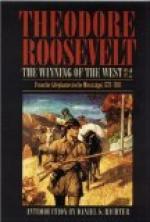the battle was the success with which, after every
retreat, Campbell, Shelby, Sevier, and Cleavland rallied
their followers on the instant; the great point was
to prevent the men from becoming panic-stricken when
forced to flee. The pealing volleys of musketry
at short intervals drowned the incessant clatter of
the less noisy but more deadly backwoods rifles.
The wild whoops of the mountain men, the cheering
of the loyalists, the shouts of the officers, and
the cries of the wounded mingled with the reports of
the firearms, and shrill above the din rose the calling
of the silver whistle. Wherever its notes were
heard the wavering British line came on, and the Americans
were forced back. Ferguson dashed from point to
point, to repel the attacks of his foes, which were
made with ever-increasing fury. Two horses were
killed under him; [Footnote: Ferguson’s
“Memoir,” p. 32.] but he continued to
lead the charging parties; slashing and hewing with
his sword until it was broken off at the hilt.
At last, as he rode full speed against a part of Sevier’s
men, who had almost gained the hill crest, he became
a fair mark for the vengeful backwoods riflemen.
Several of them fired together and he fell suddenly
from his horse, pierced by half a dozen bullets almost
at the same instant. The gallant British leader
was dead, while his foot yet hung in the stirrup.
[Footnote: The “South Carolina Loyalist”
says he was killed just as he had slain Col.
Williams “with his left hand.” Ramsey,
on the other side, represents Col. Williams as
being shot while dashing forward to kill Ferguson.
Williams certainly was not killed by Ferguson himself;
and in all probability the latter was slain earlier
in the action and in an entirely different part of
the line. The “Loyalist” is also in
error as to Cleavland’s regiment being the first
that was charged. There is no ground whatever
for the statement that Ferguson was trying to escape
when shot; nor was there any attempt at a charge of
horsemen, made in due form. The battle was purely
one of footmen and the attempt to show an effort at
a cavalry charge at the end is a simple absurdity.]
The silver whistle was now silent, but the disheartened
loyalists were rallied by De Peyster, who bravely
continued the fight. [Footnote: In his Hist.
Mag. article Gen. Watts De Peyster clears his namesake’s
reputation from all charge of cowardice; but his account
of how De Peyster counselled and planned all sorts
of expedients that might have saved the loyalists
is decidedly mythical.] It is said that he himself
led one of the charges which were at this time made
on Cleavland’s line; the “South Fork”
men from the Catawba, under Hambright and Chronicle,
being forced back, Chronicle being killed and Hambright
wounded. When the Americans fled they were scarcely
a gun’s length ahead of their foes; and the
instant the latter faced about, the former were rallied
by their officers, and again went up the hill.
One of the backwoodsmen was in the act of cocking




